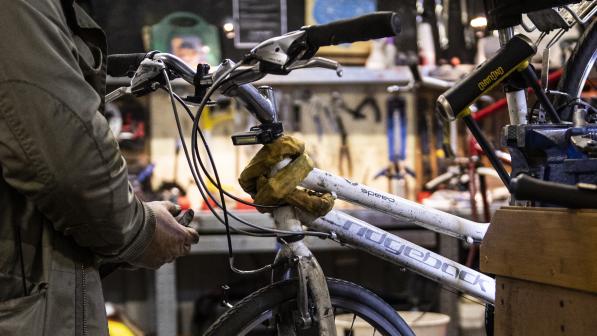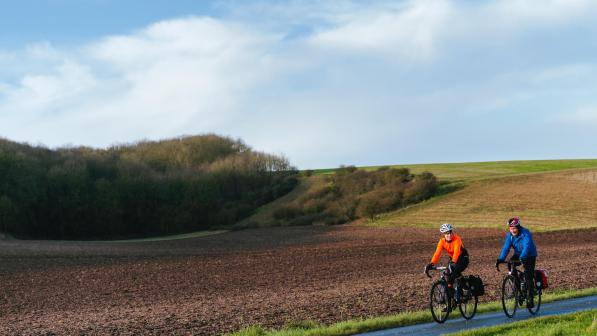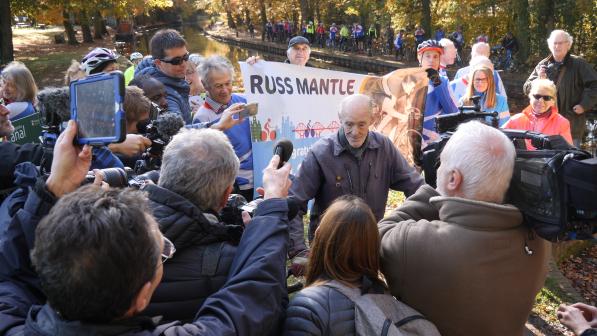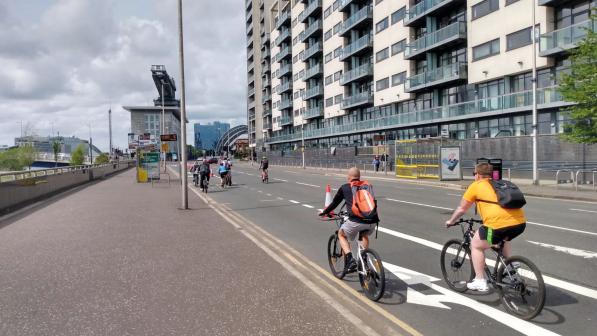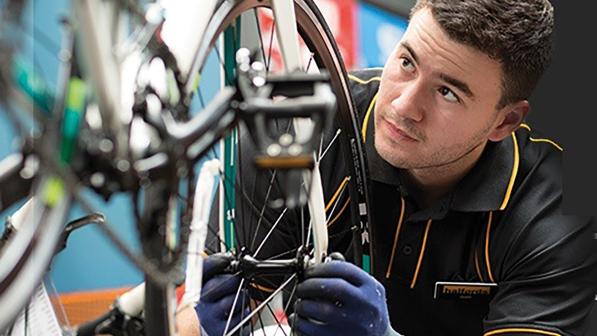What does the future hold for the cycle industry?

Coronavirus is awful, clearly, but it has been undeniably transformative for cycling. “Getting out on bikes has made a big difference to us as a family,” one young mum told me.
I spotted Emma Hamer cycling over the car-free Millennium Bridge that links Gateshead to Newcastle. She was pulling her smiling daughters behind her in a child trailer. The bike was a lockdown purchase, as was the trailer. With cleated shoes, husband James was the family’s cyclist – he now has three converts.
“We had never been out for family cycle rides [before the pandemic], but now we go out every weekend,” enthused Emma, a PE teacher. Critically, this conversion to cycling isn’t just recreational. “I now cycle to and from work three times a week,” she said.
Transport matters
There will be no cycling revolution in the UK unless there’s an uplift in transport cycling, unless cycling to work becomes a habit. That is if there’s work to go to. Millions are still furloughed, others have lost their jobs, and working from home is likely to become the norm for many.
Every transport mode took a hit during the first lockdown. According to the Bicycle Association, the number of commuter cyclists fell by 23% between March and May 2020. Yet with traffic-free roads, gorgeous spring weather, government advice to exercise – and nothing much else to do other than binge watch TV – plenty of people turned to recreational cycling. Some will become everyday cyclists.
I've already ordered my 2022 Konas, and I've done a hefty forward order with Gazelle
Graeme Hart, Hart Cyclery, Edinburgh
As the pandemic eases, the various dislocations to transport normality wrought by the coronavirus will remain significant long after most of us have had the jab. There could be both an individual and an institutional willingness to do things differently. We saw an inkling of that during spring and early summer last year with the rapid deployment of ‘popup’ cycleways. Many of these were just as rapidly removed by change-averse councils, but a good number remain.
It’s similar for the fresh influx of people who – perhaps much to their surprise – are now cycling on a more regular basis. The Sport England Active Lives Survey found that the number of adults cycling increased year-on-year by 10% in spring 2020. Add to that the 200,000 children who the Bicycle Association estimates are now cycling more regularly, and the number of newbies – ‘Coronavirus cyclists’, if you will – totals more than one million. Not all will continue cycling, but many will.
A second surge?
Bike shops have hardly ever been busier. “I’ve already ordered my 2022 Konas,” said Graeme Hart, owner of Edinburgh’s Hart Cyclery, “and I’ve done a hefty forward order with Gazelle, when I normally don’t bother because the factory and warehouse normally have such good availability.”
“I’ve never seen anything like it,” said Maurice Burton, who took over London’s De Ver Cycles in 1987. “[The boom] was quite unbelievable – we were selling in a month what we used to sell in a year.”
Heady stuff, and we could be on the cusp of a second wave of heightened demand because not everybody who wanted to buy a cycle during the 2020 bike boom was able to do so. At the peak, when there were queues out onto the street, many bike shops reported a new-to-existing customer ratio of about 70%-to- 30%. It’s usually the other way around.
Bike shops ran out of bikes when there was still plenty of demand. That bodes well for this year. Pleasingly, for both bike shops and suppliers (although not so good for budget-conscious consumers), a year-on-year rise of 60% in overall market value led to a 26% increase in average prices, according to the Bicycle Association.
Our average gravel bike before lockdown was selling for about £1600; afterward it went to £3200
Nic Vieri, Backyard Bicycle Shop, Gateshead
Last year, the average cost of a new bike rose from £285 in April to £391 in July. (By comparison, the average selling price of a bike in Germany in 2019 was £887.)
The more rarefied end of the market experienced a similar boost. “Our average gravel bike before the lockdown was selling for about £1,600; afterward it went to £3,200,” said Nic Vieri of Gateshead’s Backyard Bicycle Shop, named by BikeBiz as Britain’s Best Independent Bike Retailer of 2019.
Trevor Hughes of Vielo, which markets its own-brand bikes and distributes Lightweight wheels of Germany, said demand was sky-high even for £15,000-build bikes. “One of the bike shops we supply was selling five or six pairs [of £8,000 Lightweight wheels] a week,” he said. “That’s what we’d normally expect to see via that shop in a good month.”
Supply setbacks
At the height of the boom, some bike shops could name their prices for bikes. Suppliers, too, were able to shift dead stock that had lain unloved in warehouses for years. Discounting – a sales technique that usually blights the industry – dried up.
“Most of our suppliers have hit us with middle-of-the-season price increases,” said Josh Hon of Tern, maker of the iconic GSD compact e-cargo bike. “This is usually a strict no-no in the industry because retail prices are set and catalogues printed. But [2020 was] an anomaly and suppliers said, ‘Our costs have increased and if you want delivery of parts you need to accept these increases.’”
Almost overnight, selling bikes – for all bicycle retailers, including those hanging on by their fingertips after a lacklustre several years – became profitable. Many bike shops treat bicycles as ‘loss leaders’ to attract customers. It’s workshop servicing that brings home the bacon for most independent and chain bike shops.
Our lead-times are so long that we simply sold what we'd ordered, plus our float stock
Isla Rowntree, Islabikes
Fixing existing bikes to get them back on the road and – for those shops who could stand the bureaucracy – the slow-burn impact of the Government’s £50 service vouchers scheme led to a 40% year-on-year uplift in workshop takings by September.
The UK cycling market’s total value increased by 40%, estimates the Bicycle Association, rising from £1.6 billion in 2019 to £2.2 billion in 2020. Big numbers, but don’t get the impression that every bike company is now in clover. Most bike companies are relatively small and usually under-capitalised.
“There is a perception that the cycle industry has profited from a massive boom, but our lead-times are so long that for most of last year, we simply sold what we’d forecasted and ordered, pre-coronavirus, plus our float stock,” said Islabikes founder Isla Rowntree.
Her company reported a 12% increase in turnover for 2020. Good but constrained by the slow supply chain. “We could only sell what was already planned in,” she said.
Gauging the new normal
It’s likely that demand for cycles, and cycling usage in general, will remain strong for much of 2021. Because of product shortages, bikes are likely to remain in short supply for at least the first half of the year, perhaps even longer.
“Bikes are made of components from 30 to 40 suppliers,” said Tern’s Josh Hon. “If one part is missing, you can’t ship the bike. Lead times are at unheard-of levels right now. One of our suppliers is at 400 days. Most of our other suppliers are at nine to twelve months.”
Long lead times, and lack of bikes in shops, make it feel as though the boom is continuing. The cycle industry is wary of booms because it knows that busts generally follow. Many industry veterans remain scarred by the financial flops that followed the BMX, mountain bike and road bike booms of recent times.
“A more optimistic scenario,” predicts a Bicycle Association report, “is that a steady, gradual growth curve will be established, but from a higher baseline.”
Backyard’s Nic Vieri agrees: “The industry had previously been in decline, and even if we only retain 10 or 20% of all the new customers, that’s a 10 or 20% growth that we weren’t expecting.”
This rosy outlook might have once encouraged bike companies to massively increase orders from their mainly Asian factories. However, many remain worried that if demand stops as quickly as it started, they will be on the hook for potentially millions of pounds in inventory.
That would be good for consumers – lots of discounted bikes online and in shops – but ruinous for an industry that has lived from hand to mouth for many years.
Magnitude of orders
Most of the industry executives I spoke to told me they have put in larger than usual orders, but they remain wary that 2020 could have been a one-off. For all the talk of larger orders, there have been no announcements about expanding or building new Asian factories to increase capacity.
Other suppliers are playing it just as cool. “We have been fairly conservative with our forward ordering,” said Isla Rowntree. “It is better to be sure you will sell what you commit to than overstretch and risk being left with lots of stock. I’m in the business of providing people with a great cycling experience, not gambling.”
Demand will catch up with supply only later in 2021, said Ian Hughes of Vielo: “Speaking with our suppliers, they believe the catch-up will probably be around the third or the fourth quarter of 2021.” Even if a tap could be turned on to make enough bicycles to meet demand earlier, there would be no way of getting them shipped.
“There is a massive shortage of containers in Asia,” said Tern’s Josh Hon. “We’ve had a shipment of GSDs ready to go, but they’ve been delayed for several weeks because the containers we book keep getting cancelled.
“We expect demand to slow from its current ridiculous pace,” he added, “but with so many governments stepping in to invest in cycling infrastructure, we expect to see cycling increase as a transportation option for many. It’s just sad that it took a global pandemic and hundreds of thousands of deaths to get people to realise it.”
How to keep bums on bikes
What should the industry do to sustain the boom? Support us, says Cycling UK’s Matt Mallinder.
Bike shop staff have been unsung heroes in the pandemic, fixing and selling bikes so key-workers and others could ride.
But those newly back on bikes need support to keep on riding – something Cycling UK specialises in. So if we want the bike boom to continue, the industry needs to get behind the work of organisations like Cycling UK.
It is beginning to do this, by backing our Pumped UP campaign and the #BikeisBest movement, but this needs to continue into 2021 and beyond.
